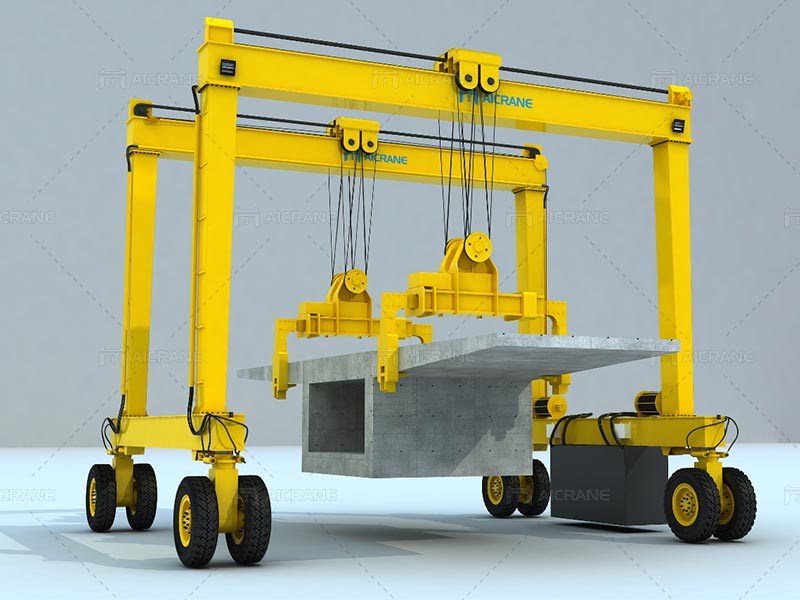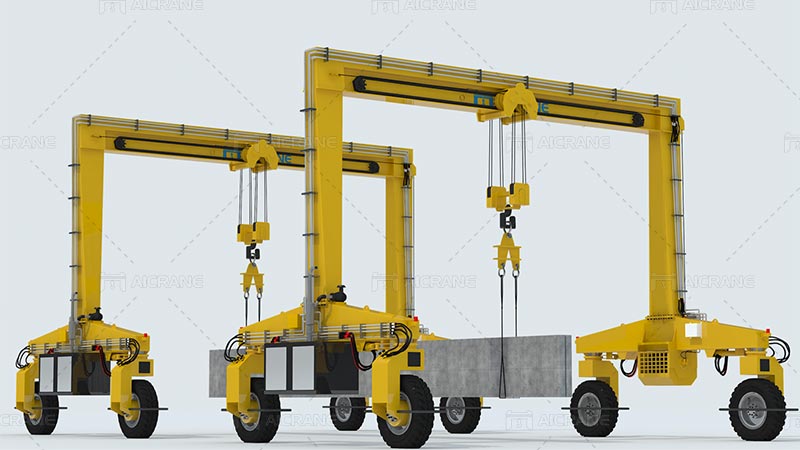In the world of precast concrete manufacturing, efficiency and precision are crucial to meet production demands and ensure high-quality results. Rubber tired gantry cranes (RTGs) have emerged as pivotal equipment in this sector, revolutionizing how precast concrete elements are handled, transported, and stored. This article explores the integral role of RTGs in precast concrete handling, highlighting their operational advantages, key features, and the impact on overall productivity.

Understanding Rubber Tired Gantry Cranes
Rubber tired gantry cranes are mobile cranes with wheels that allow them to traverse various surfaces, such as asphalt or concrete, without the need for rail tracks. Unlike rail-mounted gantry cranes, rubber tired gantry cranes offer greater flexibility in movement and can be easily repositioned within a manufacturing facility or construction site. Their primary application in the precast concrete industry includes handling and transporting concrete elements, such as beams, columns, and panels, from the production area to storage or delivery points.
Advantages of RTGs in Precast Concrete Handling
- Flexibility and Mobility The inherent mobility of RTGs provides a significant advantage in precast concrete operations. Unlike fixed rail systems, RTGs can navigate through tight spaces and various surfaces, making them ideal for handling concrete elements in dynamic manufacturing environments. This flexibility allows for the efficient organization of the production area and reduces downtime associated with repositioning and reconfiguration of equipment.
- Increased Efficiency RTGs are designed for rapid and precise movement, which enhances overall operational efficiency. With their ability to travel long distances quickly and handle heavy loads, RTGs minimize the time required for moving precast concrete elements between different stages of production and storage. This speed and efficiency contribute to a smoother workflow and increased output in precast concrete manufacturing.
- Reduced Infrastructure Costs One of the significant benefits of RTGs is the reduction in infrastructure costs. Since RTGs do not require fixed rail systems, the associated installation and maintenance costs are considerably lower. This cost-effectiveness makes RTGs an attractive option for precast concrete manufacturers looking to optimize their operations without incurring substantial expenses for infrastructure.
- Enhanced Load Handling RTGs are equipped with advanced load handling systems, including powerful hoists and precise control mechanisms. These features enable RTGs to lift and move heavy precast concrete elements with precision and safety. The ability to handle varying load sizes and weights ensures that RTGs can accommodate the diverse needs of precast concrete production, from smaller components to large structural elements.
- Improved Safety Safety is a critical concern in precast concrete handling, given the substantial weights and complex movements involved. RTGs are designed with robust safety features, including load monitoring systems, emergency stop functions, and ergonomic controls. These safety measures help prevent accidents and ensure that concrete elements are handled and transported safely throughout the production process.

Key Features of RTGs for Precast Concrete Handling
- High Lifting Capacity RTGs are available in various lifting capacities, ranging from smaller models suitable for lighter precast elements to heavy-duty versions capable of handling substantial loads. The high lifting capacity of RTGs is essential for managing the large and heavy concrete components typical in precast concrete production.
- Versatile Reach and Span RTGs come with adjustable reach and span capabilities, allowing them to handle precast concrete elements of different sizes and configurations. The ability to extend and retract the crane’s reach ensures that RTGs can access and maneuver around various production and storage areas, providing versatility in handling concrete components.
- Advanced Control Systems Modern RTGs are equipped with advanced control systems that enhance their operational precision and ease of use. These systems may include computerized controls, load sensors, and real-time monitoring, allowing operators to manage the crane’s movements and load handling with greater accuracy and efficiency.
- Durable and Robust Design Given the demanding nature of precast concrete handling, RTGs are designed to withstand harsh operating conditions. The heavy duty gantry cranes are built with durable materials and components that can endure the stresses associated with heavy lifting and frequent use. This robustness ensures long-term reliability and minimal downtime for maintenance.
Impact on Precast Concrete Production
- Streamlined Workflow The integration of RTGs into precast concrete production facilities streamlines the workflow by enabling efficient handling and transportation of concrete elements. The ability to quickly and accurately move components between production, storage, and delivery areas reduces delays and improves overall productivity.
- Enhanced Quality Control RTGs contribute to improved quality control in precast concrete production by ensuring precise placement and handling of concrete elements. Accurate positioning and movement help prevent damage to the components and maintain their structural integrity, resulting in higher-quality finished products.
- Increased Production Capacity By enhancing efficiency and reducing downtime, RTGs enable precast concrete manufacturers to increase their production capacity. The ability to handle large volumes of concrete elements quickly and effectively translates to higher output and greater profitability for manufacturers.
- Optimized Storage and Inventory Management RTGs facilitate better storage and inventory management by providing the flexibility to arrange and access precast concrete elements in an organized manner. This optimization of storage space helps manufacturers maintain a well-organized inventory and reduces the risk of damage or loss of concrete components.
Conclusion
Rubber tired gantry cranes have become indispensable in the precast concrete industry, offering a range of benefits that enhance efficiency, safety, and productivity. Their flexibility, high lifting capacity, and advanced features make them ideal for handling and transporting precast concrete elements with precision and ease. As the demand for precast concrete continues to grow, the role of Aicrane RTGs in streamlining production processes and optimizing operations will remain crucial to meeting the industry’s needs. By leveraging the advantages of RTGs, precast concrete manufacturers can achieve greater operational success and contribute to the advancement of construction technology.